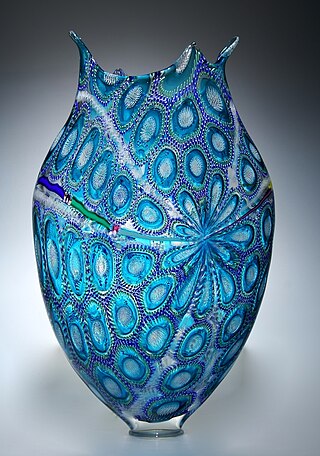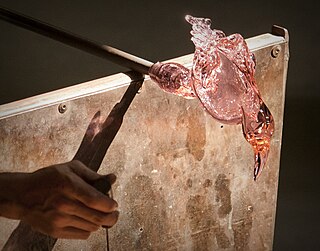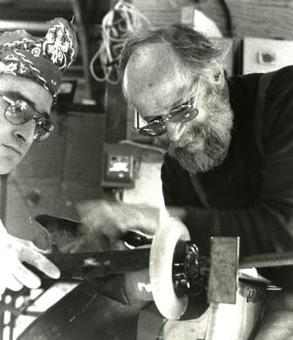
Studio glass is the modern use of glass as an artistic medium to produce sculptures or three-dimensional artworks. The glass objects created are intended to make a sculptural or decorative statement. Though usage varies, the term is properly restricted to glass made as art in small workshops, typically with the personal involvement of the artist who designed the piece. This is in contrast to art glass, made by craftsmen in factories, and glass art, covering the whole range of glass with artistic interest made throughout history. Both art glass and studio glass originate in the 19th century, and the terms compare with studio pottery and art pottery, but in glass the term "studio glass" is mostly used for work made in the period beginning in the 1960s with a major revival in interest in artistic glassmaking.

A paperweight is a small solid object heavy enough, when placed on top of papers, to keep them from blowing away in a breeze or from moving under the strokes of a painting brush. While any object, such as a stone, can serve as a paperweight, decorative paperweights of glass are also produced, either by individual artisans or factories. The decorative paperweights are usually in limited editions, and are collected as works of fine glass art, some of which are exhibited in museums. First produced in about 1845, particularly in France, such decorative paperweights declined in popularity before undergoing a revival in the mid-twentieth century.

Salem Community College (SCC) is a public community college in Salem County in the U.S. state of New Jersey. Salem Community College's main 11-acre (45,000 m2) campus is in Carneys Point Township. SCC is authorized to grant associate degrees, including Associate in Arts, Associate in Fine Arts, Associate in Science, and Associate in Applied Science certificates. SCC also offers the only degree program in the US for scientific glassblowing.

Wheaton Arts and Cultural Center is a 501(c)(3)non-profit arts education organization, with a focus on the medium of glass. Located in Millville, New Jersey, the center's mission is to engage artists and audiences in an evolving exploration of creativity.

Harvey Littleton was an American glass artist and educator, one of the founders of the studio glass movement; he is often referred to as the "Father of the Studio Glass Movement". Born in Corning, New York, he grew up in the shadow of Corning Glass Works, where his father headed Research and Development during the 1930s. Expected by his father to enter the field of physics, Littleton instead chose a career in art, gaining recognition first as a ceramist and later as a glassblower and sculptor in glass. In the latter capacity he was very influential, organizing the first glassblowing seminar aimed at the studio artist in 1962, on the grounds of the Toledo Museum of Art. Imbued with the prevailing view at the time that glassblowing could only be done on the factory floor, separated from the designer at his desk, Littleton aimed to put it within the reach of the individual studio artist.
Marvin Bentley Lipofsky was an American glass artist. He was one of the six students that Studio Glass founder Harvey Littleton instructed in a program at the University of Wisconsin-Madison in fall 1962 and spring 1963. He was a central figure in the dissemination of the American Studio Glass Movement, introducing it to California through his tenure as an instructor at the University of California, Berkeley and the California College of Arts and Crafts.
The firm of James Powell and Sons, also known as Whitefriars Glass, were London-based English glassmakers, leadlighters and stained-glass window manufacturers. As Whitefriars Glass, the company existed from the 17th century, but became well known as a result of the 19th-century Gothic Revival and the demand for stained glass windows.

Dominick Labino (1910–1987) was an internationally known scientist, inventor, artist and master craftsman in glass. Labino's art works in glass are in the permanent collections of more than 100 museums throughout the world. Labino held over 60 glass-oriented patents in the United States.

Richard "Dick" Marquis is an American studio glass artist. One of the first Americans ever to work in a Venetian glass factory, he became a master of Venetian cane and murrine techniques. He is considered a pioneer of American contemporary glass art, and is noted for his quirky, playful work that incorporates flawless technique and underlying seriousness about form and color.
Preston Singletary is a Native American glass artist.

Dan Owen Dailey is an American artist and educator, known for his sculpture. With the support of a team of artists and crafts people, he creates sculptures and functional objects in glass and metal. He has taught at many glass programs and is professor emeritus at the Massachusetts College of Art, where he founded the glass program.

Richard Ritter is an American studio glass artist who lives in North Carolina.
Fritz Dreisbach is an American studio glass artist and teacher who is recognized as one of the pioneers of the American Studio Glass Movement.

Glass art refers to individual works of art that are substantially or wholly made of glass. It ranges in size from monumental works and installation pieces to wall hangings and windows, to works of art made in studios and factories, including glass jewelry and tableware.
Linda MacNeil is an American abstract artist, sculptor, and jeweler. She works with glass and metal specializing in contemporary jewelry that combines metalwork with glass to create wearable sculpture. Her focus since 1975 has been sculptural objets d’art and jewelry, and she works in series. MacNeil’s jewelry is considered wearable sculpture and has been her main focus since 1996.

Karen LaMonte is an American artist known for her life-size sculptures in ceramic, bronze, marble, and cast glass.
William Warmus is a curator, art critic, and author focusing on transparent media.

Amber Cowan is an American artist and educator living and working in Philadelphia. Cowan creates fused and flameworked glass sculptures from cullet and recycled industrial glass.
Bruce W. Pepich is an expert in American and international craft, and executive director and curator of collections at the Racine Art Museum (RAM) and Charles A. Wustum Museum of Fine Arts (Wustum) in Racine, Wisconsin. In Pepich's time at RAM, the contemporary craft collection has increased in size from 253 pieces to almost 10,000 pieces in 2018, one of the largest collections in the United States. Pepich is an Honorary Fellow of the American Craft Council (ACC), in recognition of his contributions to the field of contemporary American crafts.
Joey Kirkpatrick is an American glass artist, sculptor, wire artist, and educator. She has taught glassblowing at Pilchuck Glass School. Since the 1970s, her artistic partner has been Flora Mace and their work is co-signed. Kirkpatrick has won numerous awards including honorary fellow by the American Craft Council (2005).













